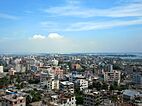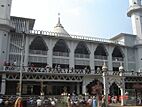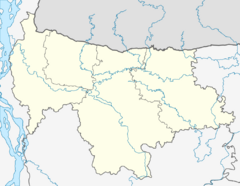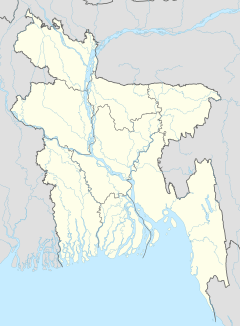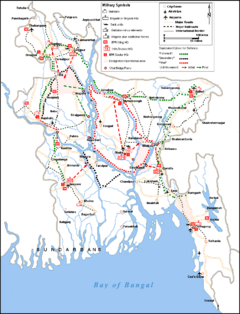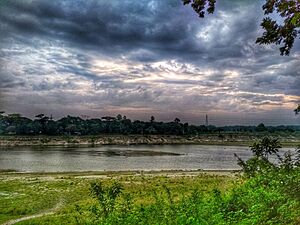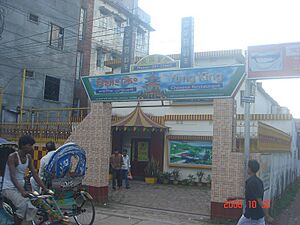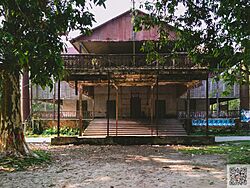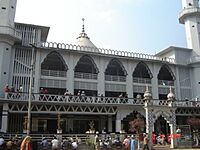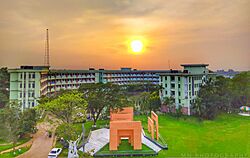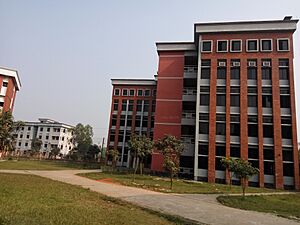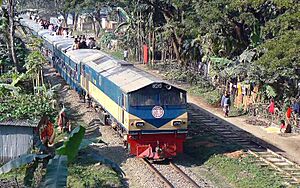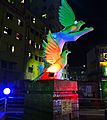Mymensingh facts for kids
Quick facts for kids
Mymensingh
ময়মনসিংহ
|
|
|---|---|
|
Shashi Lodge
Mymensingh City Skyline
Boro Masjid
Bangladesh Agricultural University
Zainul Abedin Museum
Mymensingh Medical College
|
|
| Nicknames:
Momenshahi, Momishing, Moishing, Nasirabad, Green City
|
|
| Country | |
| Division | Mymensingh Division |
| District | Mymensingh District |
| Establishment | 1787 |
| Granted city status | 1787 |
| Government | |
| • Type | Mayor–Council |
| • Body | Mymensingh City Corporation |
| Area | |
| • Metropolis | 91.315 km2 (35.257 sq mi) |
| • Metro | 91.315 km2 (35.257 sq mi) |
| Elevation | 19 m (62 ft) |
| Population
(2022)
|
|
| • Metropolis | 576,927 |
| • Density | 6,317.99/km2 (16,363.51/sq mi) |
| • City rank | 8th in Bangladesh |
| • Metro rank | 8th in Bangladesh |
| Demonym(s) | Moymonshinga |
| Languages | |
| • Official | Bengali • English |
| Time zone | UTC+6 (BST) |
| Postal codes |
2200, 2201, 2202, 2203, 2204, 2205, 2206, 2207, 2208
|
| UN/LOCODE | BD MYM |
| Calling code | +88091 |
| Police | Mymensingh Range Police |
Mymensingh (Bengali: ময়মনসিংহ, romanized: Maẏamanasinha) is a big city and the capital of Mymensingh Division in Bangladesh. It is located on the bank of the Brahmaputra River. The city is about 120 kilometers (75 miles) north of Dhaka, the capital of Bangladesh. Mymensingh is an important place for money matters and education in north-central Bangladesh. It is also the main office for Mymensingh District and Mymensingh Division. In 2022, Mymensingh City Corporation was the 7th largest city by area and the 8th largest by population in Bangladesh. It had 576,927 people living there.
The British East India Company officially started the city on May 1, 1787. Mymensingh is ranked 4th among districts in Bangladesh. It is the second most crowded city in Bangladesh, with about 44,458 people living in each square kilometer. Many people visit Mymensingh for medical reasons, making up 25 percent of all health tourists in Bangladesh. The name Mymensingh comes from "Momen Singh," a Muslim ruler. The city is about 19 meters (62 feet) above sea level, which is the highest among major cities in Bangladesh. Mymensingh is also close to Tura, Meghalaya, a city in Meghalaya, India.
Mymensingh is known for the Old Brahmaputra River. It is also famous for special handmade blankets called Nakshikantha (Bengali: নকশীকাঁথা). A type of folk song called Maimansingha Gitika also comes from here. The city is well-known for its many schools and colleges.
Contents
History of Mymensingh
Mymensingh is one of Bangladesh's oldest districts. It was created by the British East India Company on May 1, 1787. The city has a long history, being over 220 years old. At first, Begunbari was chosen as the main office for the district. But after a big flood, the main office moved to Mymensingh. The city was once called Nasirabad, named after Nasiruddin Nasrat Shah. During the time of British rule, rich landowners called Talukdar Zamindars ruled this area.
Many families left Mymensingh during the Partition in 1947. More people left after the war in 1965. Even today, some people born in Mymensingh have moved to West Bengal, India.
From the early 1900s, more Muslims moved into the city. Mymensingh became important for promoting fairness and equality. Schools like Vidyamoyee Uccha Balika Bidyalaya and Muminunnesa Women's College helped educate many Bengali Muslim women. For example, Justice Nazmun Ara Sultana, the first woman judge of the High Court of Bangladesh, went to these schools. In 1969, Tangail became a separate district from Mymensingh. Then, in 1977, Jamalpur also became a new district.
The nine-month Bangladesh Liberation War started on March 27, 1971. Mymensingh was free from the Pakistani army until April 23, 1971. The Pakistani forces left Mymensingh on December 10. The Mukti Bahini (freedom fighters) took control on December 11, just five days before Bangladesh won its independence on December 16.
Geography and Climate
Mymensingh city does not have clear borders. It has grown quickly since the 1980s. The Old Brahmaputra River flows along the north side of the city. Shambhuganj is on the other side of the river, connected by a bridge. Other parts of the city include the start of the Bangladesh Agricultural University campus, the Mymensingh Medical College, the Army area, and Sultanabad. A railway line built between 1885 and 1899 goes through the city, dividing it into two parts.
The weather in Mymensingh is a bit cooler than in Dhaka. This is because it is closer to the Himalayas. It has a humid subtropical climate. The monsoon season starts in May or June and lasts until August. It rains a lot during this time, sometimes for days or weeks. In monsoon, the temperature is usually between 25 and 31 degrees Celsius (77 and 88 degrees Fahrenheit). In winter, which is from December to January, the temperature can drop below 15 degrees Celsius (59 degrees Fahrenheit). The hottest time is in April and May, when temperatures can reach 40 degrees Celsius (104 degrees Fahrenheit). High humidity makes it feel even hotter then. The best time to visit is from November to February.
| Climate data for Mymensingh (1991-2020) | |||||||||||||
|---|---|---|---|---|---|---|---|---|---|---|---|---|---|
| Month | Jan | Feb | Mar | Apr | May | Jun | Jul | Aug | Sep | Oct | Nov | Dec | Year |
| Record high °C (°F) | 32.3 (90.1) |
35.5 (95.9) |
41.1 (106.0) |
43.3 (109.9) |
42.8 (109.0) |
41.0 (105.8) |
41.6 (106.9) |
40.2 (104.4) |
38.2 (100.8) |
37.6 (99.7) |
34.8 (94.6) |
31.0 (87.8) |
43.3 (109.9) |
| Mean daily maximum °C (°F) | 24.0 (75.2) |
27.0 (80.6) |
30.5 (86.9) |
31.7 (89.1) |
31.8 (89.2) |
31.7 (89.1) |
31.5 (88.7) |
31.9 (89.4) |
31.7 (89.1) |
31.5 (88.7) |
29.5 (85.1) |
25.8 (78.4) |
29.9 (85.8) |
| Daily mean °C (°F) | 17.3 (63.1) |
20.6 (69.1) |
24.4 (75.9) |
26.7 (80.1) |
27.6 (81.7) |
28.4 (83.1) |
28.5 (83.3) |
28.8 (83.8) |
28.3 (82.9) |
26.9 (80.4) |
23.0 (73.4) |
18.9 (66.0) |
24.9 (76.8) |
| Mean daily minimum °C (°F) | 11.8 (53.2) |
15.0 (59.0) |
19.0 (66.2) |
22.2 (72.0) |
23.8 (74.8) |
25.7 (78.3) |
26.2 (79.2) |
26.4 (79.5) |
25.8 (78.4) |
23.4 (74.1) |
18.0 (64.4) |
13.6 (56.5) |
20.9 (69.6) |
| Record low °C (°F) | 4.2 (39.6) |
4.5 (40.1) |
8.9 (48.0) |
11.2 (52.2) |
15.2 (59.4) |
19.4 (66.9) |
22.8 (73.0) |
20.8 (69.4) |
20.8 (69.4) |
17.8 (64.0) |
8.3 (46.9) |
3.8 (38.8) |
3.8 (38.8) |
| Average precipitation mm (inches) | 8 (0.3) |
16 (0.6) |
38 (1.5) |
141 (5.6) |
312 (12.3) |
410 (16.1) |
423 (16.7) |
329 (13.0) |
305 (12.0) |
192 (7.6) |
14 (0.6) |
7 (0.3) |
2,195 (86.6) |
| Average precipitation days (≥ 1 mm) | 1 | 2 | 4 | 9 | 15 | 20 | 23 | 21 | 18 | 8 | 1 | 1 | 123 |
| Average relative humidity (%) | 77 | 72 | 71 | 77 | 81 | 86 | 87 | 86 | 86 | 83 | 79 | 79 | 80 |
| Mean monthly sunshine hours | 183.0 | 202.2 | 216.2 | 203.0 | 187.3 | 133.7 | 138.7 | 151.8 | 148.9 | 209.9 | 224.1 | 200.0 | 2,198.8 |
| Source 1: NOAA | |||||||||||||
| Source 2: Bangladesh Meteorological Department (humidity 1981-2010) | |||||||||||||
City Management
Mymensingh is the main office for one of Bangladesh's eight administrative divisions. Important government officials for the Mymensingh Division have their offices in the city. These include the Divisional Commissioner and the DIG (Deputy Inspector General) of Police. The Deputy Commissioner (DC) and Civil Surgeon for Mymensingh District also have their offices here.
The city has a mayor and ward commissioners who are elected for five-year terms. The Mymensingh City Corporation is in charge of running the city.
People of Mymensingh
| Historical population | ||
|---|---|---|
| Year | Pop. | ±% |
| 1991 | 188,713 | — |
| 2001 | 227,201 | +20.4% |
| 2011 | 258,040 | +13.6% |
| 2022 | 576,927 | +123.6% |
| sources:citypopulation.de | ||
| Religions in Mymensingh (2011) | ||||
|---|---|---|---|---|
| Religion | Percent | |||
| Islam | 86.20% | |||
| Hinduism | 13.28% | |||
| Christianity | 0.43% | |||
| Other or not stated | 0.09% | |||
In 2011, Mymensingh Municipality had 258,040 people living in 54,869 homes. About 17% of the people were under 10 years old. There were 953 females for every 1000 males. The literacy rate (people aged 7 and above who can read and write) was about 74%. By 2022, the larger Mymensingh City Corporation had 576,927 people in 135,495 homes. The number of females per 1000 males increased slightly to 965. The literacy rate also went up to 84.41%.
Economy and Business
In the past, Mymensingh was famous for growing jute. Jute was called 'golden fiber' because it brought in a lot of money. However, the jute industry has become less important due to new materials like plastic bags. Since Mymensingh is the capital of its division, many people work for the government. There are also many workers who earn money as street vendors, rickshaw drivers, taxi drivers, and mechanics. Farming is the biggest part of the economy, followed by services like shops and businesses.
Fishing is also very important to Mymensingh's economy. People have turned their rice fields into ponds to raise fish. Large Prawns are sold in great numbers, especially in winter.
The main shopping areas are between Durgabari Road and Maharaja Road. This area includes places like Ganginarpar, Boro Bazaar, Choto Bazaar, and Mechua Bazaar. Jilapi Patty is a special place for making and selling jilapi, a sweet snack. The main road from Notunbazar to the railway station has many shops selling clothes and other products.
City Center
The busiest part of Mymensingh is along Ganginarpar Road. This road is often called the "lifeline" of the city. Other busy areas include Chorpara Moor, Town Hall Moor, Zero Point Moor, and Bridge Moor.
Local Food
The main food in Mymensingh is plain rice with fish or meat curry. People often start their meal with fried or steamed vegetables and dal, which is a kind of lentil soup. They might add lemon juice, salt, fresh shallots, and green pepper for extra flavor.
Traditional snacks include different kinds of seasonal pitha (sweet or savory cakes), dal-puri (fried bread with lentils), and shingara (savory pastries). Homemade desserts include Khyr, Payesh, and Shemai, which are sweet rice or noodle puddings. Sweets soaked in sugar syrup, like Jilapi, are usually bought from shops. Many people chew Pan, a digestive made from betel nuts, spices, and other ingredients.
For dinner or lunch, people sometimes make "khichuri", a mix of rice and lentils with spices. It is served with chutney or pickles. Some people add Ghee (clarified butter) before eating. The meal might end with sweet curd. Other common foods include Muri (puffed rice), chira (flattened rice), and khoi (popped rice). These are eaten with gur (unrefined sugar), or mixed with yogurt or milk. People traditionally eat with their right hand.
Famous Places
The Old Town Hall was built in 1878 by Maharaja Surya Kanta Acharyya. It hosted many plays, meetings, and cultural events. It was taken down in 2006 and is being rebuilt.
Shashi Lodge is a historic building in the city, built in 1905.
Bangladesh Parishad, located on Chhoto Bazar Road, was a government library and cultural center. It opened in 1969 and became Bangladesh Parishad after Bangladesh became independent in 1971. It had a public library with many books and magazines. It also had a hall for literary and cultural events. Until the 1980s, it was a very active place for culture in Mymensingh.
Shishu Academy, a children's organization, opened its Mymensingh office in the 1990s.
The first Shahid Minar (a monument for martyrs) was built in 1958. It was later moved to the Town Hall area in the 1990s.
Amarabati Natya Mandir was the first theater in Mymensingh, built in the 1930s. It later became a cinema called Chayabani. The Town Hall then became the main place for plays. Bahubrihi is a drama group that has helped keep theater alive in Mymensingh since the 1970s. Singing has been popular since the 1800s. Sunil Dhar started a music school in the 1980s. Folk songs like Maimansingha Gitika are also famous.
Mymensingh has three cinema halls, though most are old. Cable TV started in 1999, and many people now watch movies at home. But for special holidays like Eid or Puja, people still go to the cinema halls. Aloka, the oldest cinema hall, was taken down in 2006 to build a new shopping and living complex. Other cinema halls are Chayabani and Purabi.
The Muslim Institute library, a public library, opened in 1934. The local Bar also has a library with law books.
The "Alexander Castle", also called "Lohar Kutir", is a special building. Maharaja Surya Kanta Acharya built it for guests like Grand Duke Boris of Russia and General Sir George White. Rabindranath Tagore also visited Alexander Castle. This building was made to be earthquake-proof after his earlier "Crystal Palace" was destroyed by a big earthquake in 1897. Later, "Shashi Lodge" was built where the "Crystal Palace" used to be. Both Alexander Castle and Shashi Lodge once held many artworks and old items from around the world. These buildings are now protected as National Heritage Monuments.
Bipin Park is a small park near Boro Bazaar, right by the Brahmaputra River.
Museums to Visit
The Mymensingh Museum opened in 1969. It has a collection of items from the palaces of old landowners in the Mymensingh area.
The Zainul Abedin Museum opened in 1975 in a house by the Brahmaputra River. This art gallery shows paintings by Zainul Abedin, who was a very important artist in Bangladesh. It also has an art school and an open-air stage.
The Fish Museum & Biodiversity Center, or FMBC, is run by Bangladesh Agricultural University. It teaches about fish and nature.
Religious Buildings
Anjuman Eid-gah Maidan
The Anjuman Eid-gah Maidan is a large prayer ground. It was built in 1962 and covers about 27 acres of land, including a pond. Every year, large gatherings for the Eid ul-Fitr and Eid ul-Adha prayers are held here in the morning. This place used to be where Maharaj Surya Kanta Acharya kept his elephants.
Durga Bari Temple
Durga Bari Temple is a main religious place for Hindus in Mymensingh. It is on Durga Bari Road. The Hindu Goddess Durga Devi is worshipped here. Religious songs called Kirtan are sung in the temple all week.
Ramakrishna Math and Mission
The Ramakrishna Ashrama in Mymensingh is located at 182, Ramakrishna Mission Road. The Ramakrishna Math is a religious organization for men, started by Sri Ramakrishna.
St Patrick's Cathedral Church
St Patrick's Cathedral Church is part of the Roman Catholic Diocese of Mymensingh. Bishop Ponen Paul Kubi leads the Diocese. Many people in this area are from the Garo tribal community. There are about 76,047 Catholics and 6,665 Protestant Christians here. Many people work as farmers or day laborers, and some move to cities for work.
Mymensingh Baptist Church
The Mymensingh Baptist Church is located near the town hall.
Sports and Recreation
The "Panditparar Math" is a large field by the Brahmaputra River, in front of the Circuit House. It is used by athletes in the city. Many famous cricket players have come from here, like Prabir Kumar Sen, who was one of the few wicket keepers to stump Don Bradman. Hemanga Bose was also a notable player. Mahmudullah, a former vice-captain of the Bangladesh national cricket team, was born in this district. Mymensingh also has one of the oldest football clubs in the country, Mymensingh Mohammedan Sporting Club, started in 1898.
Body building has become a popular hobby for many young adults in the city. The Muslim Institute has a well-equipped gym that has been open since the 1950s.
Education in Mymensingh
Many students come to Mymensingh from other districts to study. The city has many universities, colleges, and schools, including:
- Jatiya Kabi Kazi Nazrul Islam University
- Bangladesh Agricultural University
- Mymensingh Medical College
- Mymensingh Engineering College
- Mymensingh Girls' Cadet College
- Ananda Mohan College
- Shahid Syed Nazrul Islam College
- Muminunnesa Women's College
- Mymensingh Polytechnic Institute
- Nasirabad College, Mymensingh
- Agricultural University College, Mymensingh
- Notre Dame College, Mymensingh
- Women Teachers Training College
- Royal Media College
- Mymensingh Zilla School
- Vidyamoyee Govt. Girls' High School
- Govt. Laboratory High School, Mymensingh
- Mukul Niketon High School
- Cantonment Public School and College, Mymensingh
Getting Around Mymensingh
Mymensingh is about 120 kilometers (75 miles) from Dhaka. The city was connected to Dhaka by railway around 1865. The road link to Dhaka used to go through Tangail. Later, a national highway (N3) was built directly connecting Dhaka and Mymensingh. Within the city, rickshaws and "Auto" (auto-rickshaws) are the main ways to travel. The number of cars is also growing fast. Three-wheeled vehicles became common in the late 1990s.
Trains are the cheapest way to travel to Mymensingh. Several trains like Ekota Express, Tista Express, and Brahmaputra Express connect Mymensingh with Dhaka. Train fares vary depending on the class and train. It takes about 3 hours or more to reach Mymensingh from Dhaka by train. There are three main stops: Dhaka Airport railway station, Joydebpur, and Gafargaon Upazila. All inter-city trains also connect Mymensingh with Jamalpur town. Local trains run between Mymensingh and Kishoreganj and Netrokona. A special train called "Dholesshori Express" started running from Mymensingh to "Bongobondhu Jamuna Shetu" in 2012.
Media and Literature
Bharat Mihir was one of the oldest newspapers published in Mymensingh during British rule, starting in 1875. After Bangladesh became independent in 1971, the first daily newspaper, Dainik Jahan, was published in 1979. Other newspapers published in the city include Dainik Ajker Bangladesh and Dainik Ajker Khabar. In the past, newspapers from Dhaka arrived around noon by train. Now, with better roads, they arrive by bus earlier in the morning.
Mymensingh Press Club, near Ganginarpar, is a lively place for writers, teachers, and cultural activists. It hosts literary and cultural events regularly. The Press Club was started in 1959. Poets like Musharraf Karim and Farid Ahmed Dulal, and writer Iffat Ara are important literary figures from Mymensingh.
State-owned Bangladesh Television has a relay television station in Mymensingh's Akua area. It is planned to become a regional television station soon.
Notable People from Mymensingh
Many famous people have connections to Mymensingh. Scientist Sir Jagadish Chandra Bose was born in Bikrampur, but his family had ties to the greater Mymensingh area. Other notable people include writer Upendra Kishore Roychowdhury, Sukumar Ray, and Leela Majumdar. The famous artist Zainul Abedin and novelist Shirshendu Mukhopadhyay received early education in Mymensingh.
Humayun Ahmed, a well-known Bengali writer, and Mahmudul Hasan, an Islamic scholar, are also from this region. Magician P.C. Sorcar and diplomat Abul Fateh have Mymensingh connections. Syed Nazrul Islam, who was the acting president of Bangladesh during the Liberation War, is from here. Two other presidents, Justice Abu Sayeed Chowdhury and Shahabuddin Ahmed, also have ties to Mymensingh.
Politician and author Abul Mansur Ahmed, former Governor of East Pakistan Abdul Monem Khan, and educationist principal Ibrahim Khan are also from Mymensingh. Poets Nirmalendu Goon, Helal Hafiz, and Abid Azad, and geologist Subhrangsu Kanta Acharyya are also notable.
Golam Samdani Quraishy, Shahid Akhand, Helena Khan, and Iffat Ara are also associated with Mymensingh.
The family of Oscar-winning Indian filmmaker Satyajit Ray and Bollywood actress Rani Mukerji are from Mymensingh. The feminist writer Taslima Nasreen also hails from the district.
Images for kids
See also
 In Spanish: Mymensingh para niños
In Spanish: Mymensingh para niños



